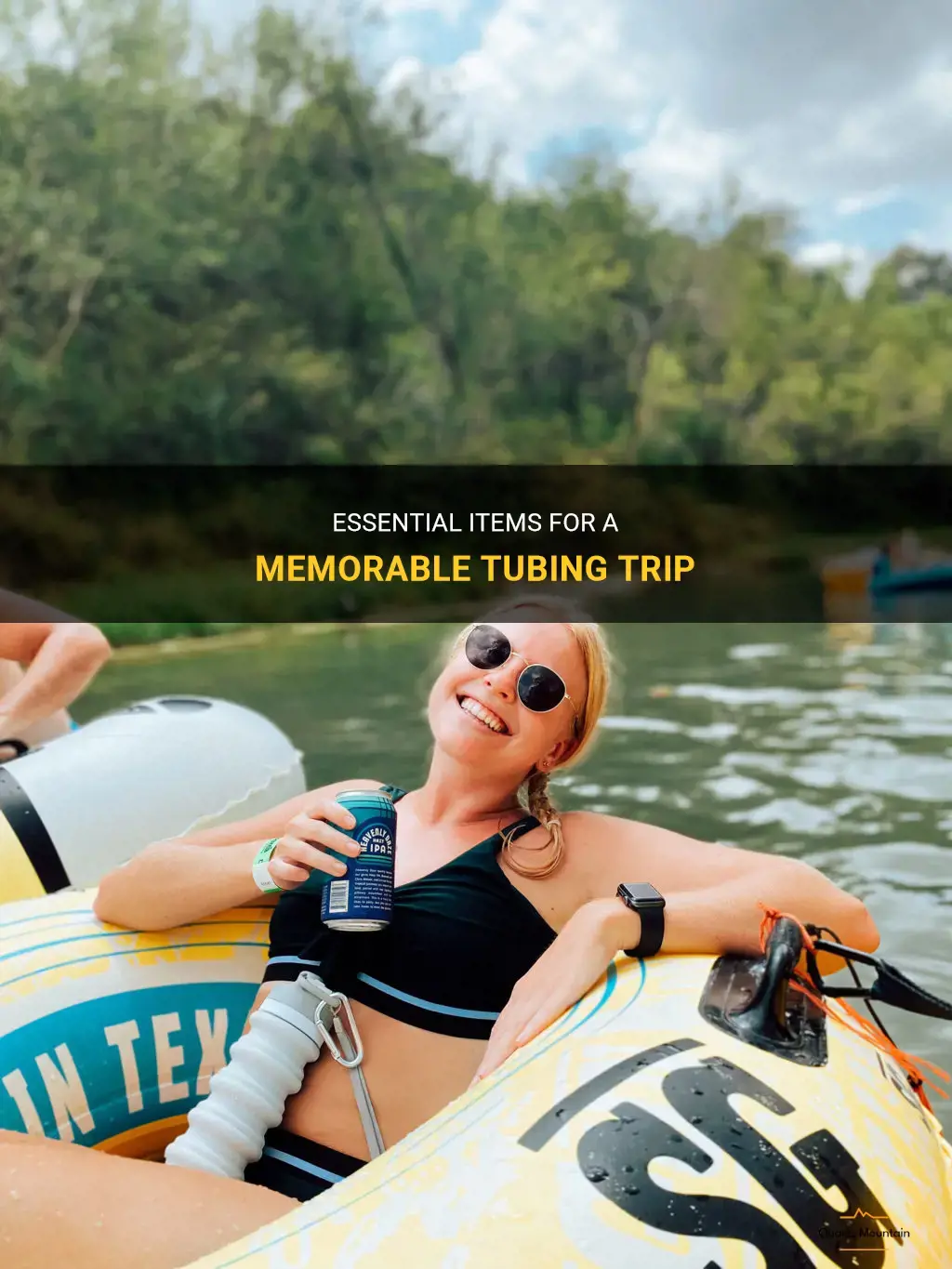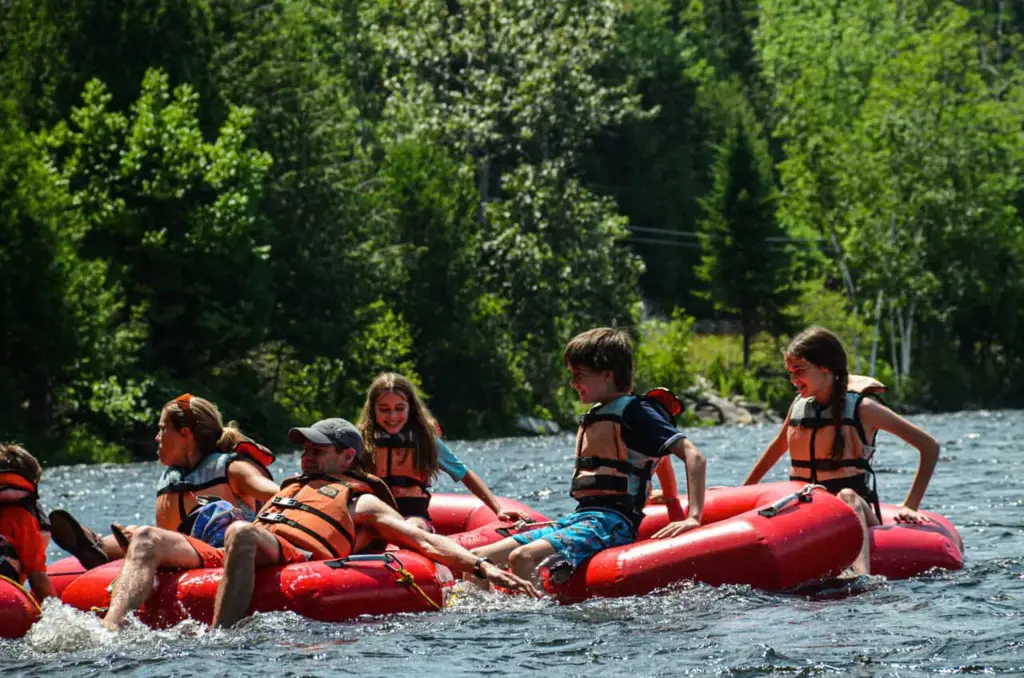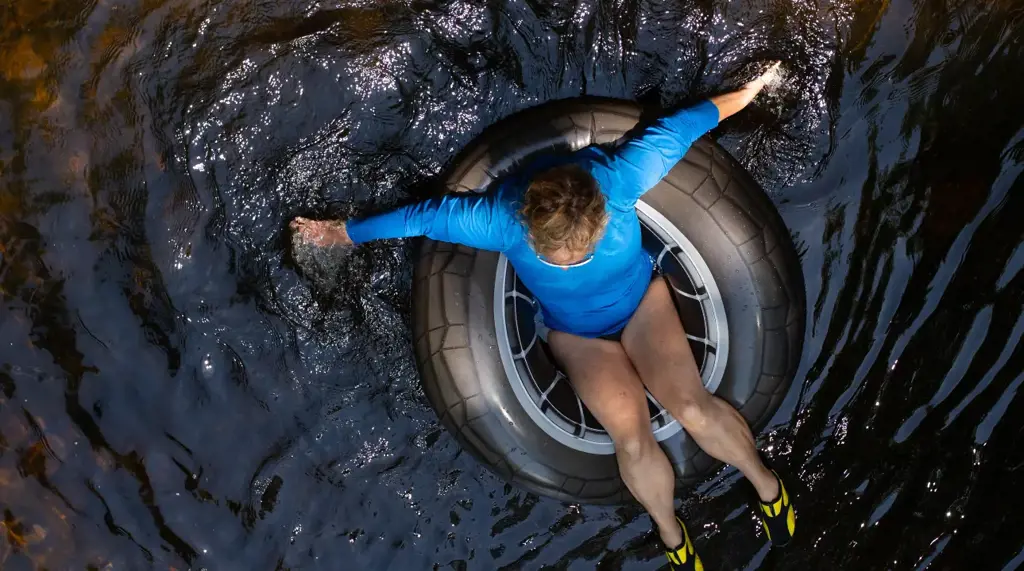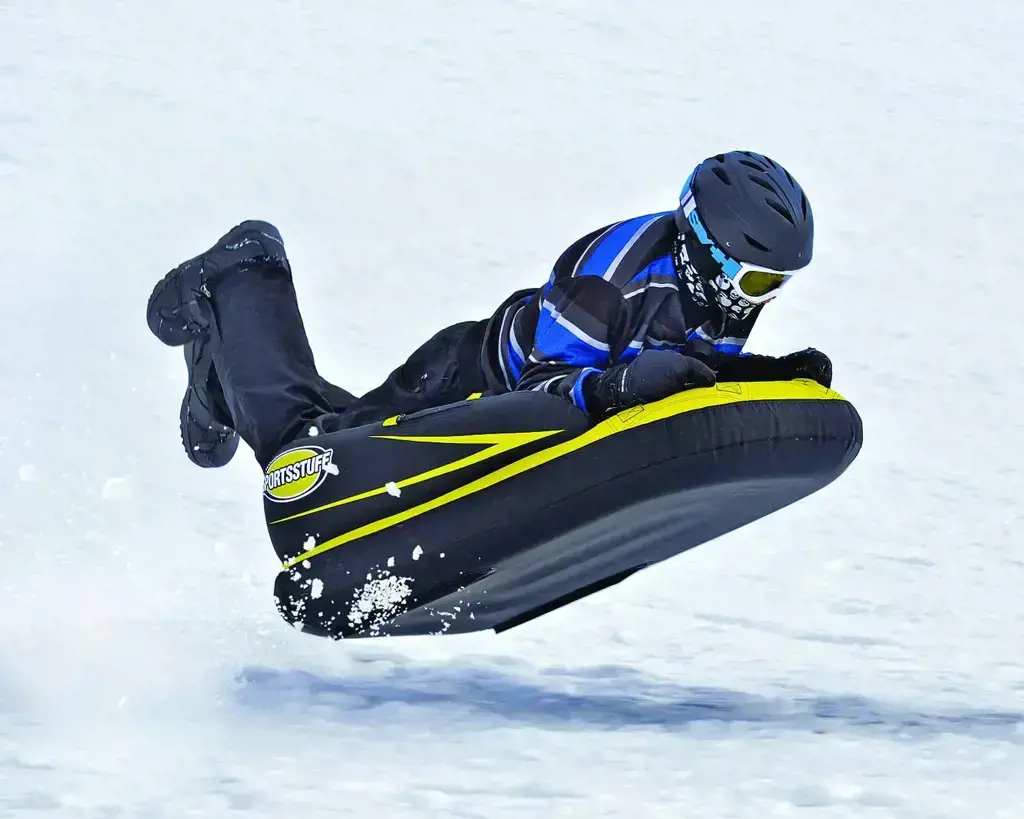
Are you ready to hit the river and have the tubing trip of a lifetime? Tubing is a fantastic way to relax and enjoy the great outdoors, but without the right essentials, your experience could be less than memorable. From sunscreen to cold beverages, we've got you covered with a list of must-have items to make your tubing adventure unforgettable. So grab your tube, buckle up, and get ready for the ride of a lifetime!
What You'll Learn
- What are the essential items to pack for a tubing trip?
- Should I bring my own tube or can I rent one at the tubing location?
- Are there any specific clothing or footwear recommendations for tubing?
- What type of sunscreen should I bring for a tubing trip?
- Are there any additional items or equipment that would enhance the tubing experience?

What are the essential items to pack for a tubing trip?

Tubing trips can be a great way to relax and have fun on the water. Whether you're floating down a lazy river or tackling some exciting rapids, it's important to pack the right essentials to ensure a safe and enjoyable experience. Here are the essential items to pack for a tubing trip:
- Tube: The most important item for a tubing trip is, of course, the tube itself. Make sure you choose a tube that is suitable for the type of water you'll be tubing in. There are different types of tubes available, such as single rider tubes and tubes with handles for more stability. Consider the size and weight capacity of the tube to ensure it can accommodate you comfortably.
- Life Jacket: Safety should always be a top priority when participating in water activities. A properly fitted life jacket is essential for everyone on the tubing trip, regardless of swimming skills. Look for a U.S. Coast Guard-approved life jacket that fits snugly and allows for easy movement.
- Sunscreen: Spending a day on the water means exposing your skin to the sun's harmful rays. Protect yourself by applying a broad-spectrum sunscreen with a high SPF before getting on the tube. Don't forget to reapply regularly, especially after getting wet.
- Hat and Sunglasses: In addition to sunscreen, a wide-brimmed hat and a pair of polarized sunglasses are essential for protecting your face and eyes from the sun. The hat will provide shade for your face and neck, while the sunglasses will reduce glare and protect your eyes from UV rays reflecting off the water.
- Water Shoes: When tubing, you're likely to encounter slippery rocks or debris on the riverbed. To protect your feet and provide better traction, invest in a pair of water shoes. These shoes are designed to drain water quickly and provide good grip on wet surfaces.
- Waterproof Phone Case: In today's digital age, many of us can't bear to be without our smartphones. To keep your phone safe from water damage, invest in a waterproof phone case. These cases will not only protect your phone from accidental water exposure but also allow you to take stunning water-related photos and videos.
- Snacks and Water: Tubing can be a tiring activity, so it's important to stay hydrated and fueled. Pack plenty of water to stay hydrated throughout the day. Additionally, bring along some snacks like fruit, energy bars, or trail mix to keep your energy levels up.
- Dry Bag: Keep your belongings dry and secure by packing them in a waterproof dry bag. This bag will protect your essentials like car keys, wallet, and extra clothes from getting wet while on the tube. Look for a dry bag with a roll-top closure for added water resistance.
- First Aid Kit: Accidents can happen, even on a tubing trip. It's important to have a basic first aid kit on hand in case of minor injuries. Include items like adhesive bandages, antiseptic wipes, pain relievers, and any necessary personal medications.
Remember, these are just the essentials. Depending on the specific tubing location and duration of your trip, you may need to pack additional items such as a portable air pump, waterproof speaker, or extra water bottles. It's always a good idea to check the specific requirements and recommendations for your tubing destination.
In conclusion, packing the right essentials is crucial for a successful and enjoyable tubing trip. From the right tube and safety gear to protective clothing, sunscreen, and snacks, these items will ensure your comfort, safety, and fun on the water. So, grab your gear, hop on your tube, and get ready for an adventure-filled tubing experience!
Essential Items to Pack for a Memorable Trip to Ethiopia
You may want to see also

Should I bring my own tube or can I rent one at the tubing location?

When planning a tubing excursion, one of the common questions that arises is whether it's better to bring your own tube or rent one at the tubing location. The answer to this question depends on several factors, including the location, the cost, and the quality of the rental tubes.
In some cases, it may be more convenient to bring your own tube. If you already own a tube and are planning to go tubing regularly, bringing your own tube can save you money in the long run. You won't have to pay the rental fees each time you go tubing, and you'll have the peace of mind knowing that you're using a tube that you're familiar with and comfortable in.
On the other hand, renting a tube at the tubing location can be a good option if you don't own a tube or if you're just tubing for a one-time event. Rental tubes are typically provided by the tubing operators and are designed specifically for the activity. They are often made of durable materials that can withstand the rough conditions of the river or the water park. Additionally, rental tubes are usually professionally inspected and maintained to ensure their safety.
Another advantage of renting a tube is that you don't have to worry about transporting it to and from the tubing location. This can be particularly beneficial if you're traveling from out of town or if you don't have a suitable vehicle to transport the tube. Most tubing locations have rental shops on-site where you can easily rent a tube for the duration of your visit.
When deciding whether to bring your own tube or rent one, it's also important to consider the cost. While rental fees can add up if you go tubing frequently, the initial cost of purchasing a high-quality tube can be quite expensive. It's important to weigh the long-term cost of owning a tube versus the short-term cost of renting one.
Ultimately, the decision of whether to bring your own tube or rent one at the tubing location will depend on your personal preferences and circumstances. If you plan to go tubing regularly, have the means to transport a tube, and are comfortable using your own equipment, bringing your own tube may be the best option. However, if you're just tubing for a one-time event or don't own a tube, renting one at the tubing location can be a convenient and cost-effective choice.
In conclusion, the question of whether to bring your own tube or rent one at the tubing location is a decision that depends on various factors. Consider the location, cost, and quality of the rental tubes, as well as your own personal circumstances and preferences. By weighing these factors, you can make an informed decision that will enhance your tubing experience.
Which Backpack Should You Bring to Bonnaroo?
You may want to see also

Are there any specific clothing or footwear recommendations for tubing?

When it comes to tubing, there are a few clothing and footwear recommendations to keep in mind for a safe and enjoyable experience. Tubing often involves floating down rivers or other bodies of water, so it's important to choose clothing and footwear that will keep you comfortable and protected.
Clothing:
- Swimwear: Wearing a swimsuit or board shorts is convenient for tubing as they dry quickly and won't weigh you down in the water. Choose a comfortable and secure fit to ensure your clothing doesn't get caught on anything during your tubing adventure.
- Rash guard or T-shirt: A rash guard or lightweight T-shirt can provide added sun protection and prevent chafing from the tube or the water. Look for clothing made from quick-drying materials that offer UV protection.
- Hat: Wearing a hat with a wide brim can help protect your face and neck from the sun's harmful rays. Opt for a hat that can be secured to your head, such as a bucket hat with a chin strap, to prevent it from getting lost in the water.
- Sunglasses: Invest in a pair of polarized sunglasses to reduce glare and protect your eyes from the sun. Make sure they are securely fitted to your face to avoid losing them during your tubing adventure.
Footwear:
- Water shoes: Water shoes are a great choice for tubing as they provide protection for your feet and help prevent slipping on rocks or other obstacles in the water. Look for water shoes that have a sturdy sole and a secure fit to ensure stability during your tubing experience. Avoid wearing flip-flops or sandals as they can easily come off in the water and may be difficult to walk in on uneven terrain.
- Neoprene socks: If you prefer not to wear water shoes, neoprene socks are a good alternative. These socks are made from a thick, water-resistant material that helps keep your feet warm and protected. They can be worn alone or with sandals for added comfort and grip.
Additional recommendations:
- Sunscreen: Apply sunscreen generously to any exposed skin at least 30 minutes before heading out on your tubing adventure. Reapply frequently, especially after spending time in the water.
- Wet/dry bag: Bring a waterproof bag to store your belongings while tubing. This will help keep them dry and prevent loss or damage.
- Extra clothing: Consider bringing a change of clothes for after your tubing adventure. You may get wet or dirty during the activity, and having a fresh set of clothes to change into can make your post-tubing experience more comfortable.
For a safe and enjoyable tubing experience, it's important to choose clothing and footwear that will protect and enhance your comfort. By following these recommendations and preparing accordingly, you can fully enjoy your time on the water without any discomfort or setbacks.
Essential Items to Pack for a Fun Day at the Amusement Park
You may want to see also

What type of sunscreen should I bring for a tubing trip?

When going on a tubing trip, it is important to bring sunscreen to protect your skin from the harmful rays of the sun. But with so many options available, what type of sunscreen should you choose? Here are a few factors to consider before making your decision.
First, it is important to choose a sunscreen with a high SPF (sun protection factor). The Skin Cancer Foundation recommends using sunscreen with an SPF of 30 or higher for adequate protection against the sun's harmful UV rays. This will help to prevent sunburns and reduce the risk of long-term damage to your skin.
Second, consider the type of sunscreen you prefer - lotion, spray, or stick. Lotions are the most common and are easy to apply to all parts of the body. Sprays can be convenient for hard-to-reach areas, but be sure to apply enough to ensure adequate coverage. Sticks are compact and great for sensitive areas like the nose and ears.
Next, think about the water-resistance of the sunscreen. Tubing trips often involve water activities, so it is important to choose a sunscreen that is water-resistant. Look for a sunscreen that is labeled as "water-resistant" or "sweat-resistant" to ensure that it will stay on your skin even while you are in the water.
Furthermore, consider the ingredients in the sunscreen. Some people may have allergies or sensitivities to certain ingredients, so it is important to choose a sunscreen that is suitable for your skin type. Look for sunscreens that are labeled as "hypoallergenic" or "fragrance-free" if you have sensitive skin.
Lastly, consider the size of the sunscreen bottle or container. Tubing trips typically involve spending a lot of time outdoors, so you will likely need to reapply sunscreen multiple times throughout the day. Choose a sunscreen that comes in a travel-sized container or a larger bottle that can easily be carried in a bag or backpack.
To illustrate these points, let's consider an example. Sarah is going on a tubing trip with her friends. She knows that they will be spending the entire day on the river, so she wants to make sure she brings the right sunscreen. Sarah chooses a sunscreen with an SPF of 50 to ensure maximum protection. She prefers a lotion sunscreen because she finds it easier to apply. Knowing that they will be in and out of the water all day, Sarah chooses a water-resistant sunscreen to ensure that it stays on her skin. Finally, Sarah checks the ingredients and chooses a sunscreen that is labeled as hypoallergenic because she has sensitive skin. She buys a travel-sized bottle of sunscreen so she can easily reapply throughout the day.
In conclusion, when going on a tubing trip, it is important to choose a sunscreen with a high SPF, consider the type of sunscreen you prefer, opt for a water-resistant formula, check the ingredients for any allergies or sensitivities, and choose the appropriate size of sunscreen for your needs. By taking these factors into account, you can ensure that you have the right sunscreen to protect your skin during your tubing adventure.
The Ultimate Guide: Packing the Perfect High School Lunch
You may want to see also

Are there any additional items or equipment that would enhance the tubing experience?

Tubing is a popular recreational activity that offers hours of fun and relaxation on the water. Whether you're floating down a lazy river or braving the rapids, there are certain items and equipment that can enhance your tubing experience.
- Tube: The first and most obvious item you'll need for tubing is a tube itself. There are various types of tubes available, including single or double rider tubes, depending on whether you want to go solo or ride with a friend.
- Life Jacket: Safety should always be a priority when participating in any water activity. Wearing a properly fitting life jacket is crucial to ensure your safety in case of an emergency. It is especially important when tubing in fast-flowing rivers or rough waters.
- Paddles: If you're planning to tube in areas where there may be calm stretches or areas with minimal currents, having a paddle can come in handy. Paddles can help you navigate through these areas more easily and give you some control over your direction.
- Waterproof Bag: Keep your belongings safe and dry by investing in a waterproof bag. This is especially useful if you plan to bring valuables, such as a phone, camera, or wallet, with you while tubing. A waterproof bag will protect your items from getting wet or damaged.
- Sun Protection: Spending hours on the water exposes you to the sun's harmful rays. To protect yourself from sunburn, it's important to bring sun protection items such as sunscreen, sunglasses, and a hat. Apply sunscreen before getting on your tube and reapply as necessary throughout the day.
- Waterproof Speaker: To enhance your tubing experience, consider bringing a waterproof speaker. Playing your favorite tunes while floating down the river can add a fun, lively ambiance to your trip. Just make sure to keep the volume at a reasonable level, respecting other tubers' desire for peace and quiet.
- Waterproof Camera: If you want to capture the memories made while tubing, invest in a waterproof camera. These cameras are designed to withstand being submerged in water and can capture high-quality images and videos even in wet conditions.
- Snacks and Drinks: Tubing can be a long and leisurely activity, so make sure to pack some snacks and drinks to keep you fueled and hydrated throughout the day. Opt for lightweight, non-perishable snacks such as granola bars or trail mix.
- Dry Bag: In addition to a waterproof bag, a dry bag can be a useful addition to your tubing gear. A dry bag is designed to keep your belongings dry even if it gets submerged in water. It offers an additional layer of protection for your valuables.
- Floating Cooler: If you're planning to spend a whole day on the water, consider bringing a floating cooler with you. This allows you to keep your drinks cool and accessible while you're tubing. Just remember to secure the cooler to your tube to prevent it from floating away.
Remember to check local regulations and safety guidelines before embarking on your tubing adventure. Some areas may have specific rules regarding the use of certain equipment or prohibit certain items altogether. Always prioritize safety and be aware of your surroundings while tubing.
Essential Items to Pack for a Day at Six Flags
You may want to see also
Frequently asked questions
When packing for a tubing trip, it's important to bring the essentials. Start with a comfortable swimsuit or swim trunks, as well as a cover-up or extra clothing for when you're out of the water. Don't forget to bring sunscreen to protect your skin from the sun's rays. It's also a good idea to pack water shoes or sandals for walking on rocky river bottoms or slippery surfaces. Lastly, bring a waterproof bag or container to keep your valuables dry and protected from water splashes.
In addition to the basics, there are a few more items that can enhance your tubing experience. Consider packing a cooler with snacks and drinks to keep you hydrated and energized throughout the day. A portable phone charger can come in handy if you want to capture photos or videos of your tubing adventure. Don't forget a waterproof camera or a waterproof phone case if you want to document your trip in the water. Lastly, it's always a good idea to bring a small first aid kit in case of any minor injuries while tubing.
There are a few items that you should avoid bringing on a tubing trip. Leave any valuables or expensive electronics at home to reduce the risk of damage or loss. It's also best to leave glass bottles behind to avoid potential accidents or littering in the water. Additionally, it's a good idea to avoid bringing any bulky or heavy items that may be difficult to carry or transport while tubing. Stick to the essentials and pack light for a more enjoyable experience.
If you are bringing young children on a tubing trip, it's important to pack extra items to ensure their safety and comfort. In addition to the usual items, bring along a life jacket for each child to wear during the tubing trip. It's also a good idea to pack snacks, drinks, and any necessary medications for the children. Bring extra towels or blankets for them to sit on and dry off with. Lastly, pack some toys or games to keep them entertained during breaks or downtime.







